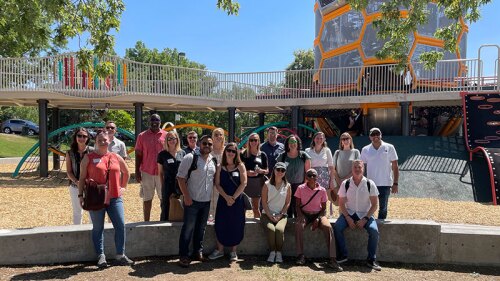During a session at the 2016 ULI Fall Meeting in Dallas, panelists involved in the ULI Healthy Corridorsproject discussed strategies for transforming unsafe, unattractive, and poorly connected commercial corridors into thriving places that further the goal of creating healthy and economically vibrant communities.
“Auto-centric commercial corridors make it challenging to walk or bike or access healthy food,” said moderator Rachel MacCleery, a ULI senior vice president who leads the Building Healthy Places Initiative. “The majority of pedestrian deaths in the U.S. occur along corridors such as this. Every community has them.” Many of these communities, she noted, are in low-income areas with minority populations. The Healthy Corridors project is working to inspire action to improve such corridors across the country.
With support from the Robert Wood Johnson Foundation and the Colorado Health Foundation, ULI is investigating best practices for removing physical and psychological barriers to improved health and reinventing underperforming arterial streets. ULI leaders from three of the four cities with demonstration corridors in the Healthy Corridors project—Los Angeles, Nashville, and Denver—as well as from a model healthy corridor in Shoreline, Washington, reported on their progress and their direction for the future.
Clare De Briere, chief executive officer and executive vice president of the Ratkovich Company in Los Angeles, said ULI Los Angeles and partners are working on a segment of Van Nuys Boulevard, the main commercial corridor in the Pacoima neighborhood north of downtown Los Angeles. Pacoima is a diverse community with a rich culture reflected in murals and small businesses that cater to the surrounding Latino community. It also faces some of the city’s poorest health outcomes: it is a food desert, with high levels of heart disease and diabetes. The segment is part of the city’s Great Streets project, launched in 2013 to provide better links within the corridor.
“We’ve focused on bringing healthy food to the community,” said De Biere.
A community facility recently built by the city along the boulevard has become “an incredible gathering place for the city,” she said. It is activated by a juice bar owned by a local family and stocked with locally sourced juices. It also hosts a food exchange where residents can trade homegrown produce. Residents can attend workshops on topics such as how to grow fruits and vegetables and how to use light rail. During the March 2016 CycLAvia cycling event through Pacoima, led by Los Angeles Mayor Eric Garcetti, the city showcased a pop-up pocket park, a bike repair station, and artists teaching about the mural tradition.
ULI Nashville is working with hospitals and many other partners to develop a brand with multiple neighborhoods along a four-mile (6.4 km) stretch of Charlotte Avenue, a primary east–west route from downtown to the western suburbs, said Ryan Doyle, vice president and general manager of oneC1TY, an urban neighborhood under construction on the corridor that is focused on healthy living, health research, business, and retail uses.
The corridor’s north side contains historically African American neighborhoods, cultural arts centers, and universities, and is also an area with social inequities and poor health outcomes. The south side contains the city’s medical district. Charlotte Avenue, a state highway, has dedicated bike lanes that are neither protected nor used.
“We want to tell the story of health with this connective tissue of routes to work, home, school, and friends,” said Doyle. “We want to leave a footprint on the city as a whole, not just in this corridor.” Doyle said Nashville has a pipeline of projects planned to coordinate with transit improvements and is focused on the city government as coordinator. A street mural by an international artist constitutes a “quick win,” he said, and the partners are analyzing the possibility of a business development district to fund efforts.
Dan Eernissee, economic development director for Shoreline, described the Aurora Corridor Project, which transformed a retail strip into a business-friendly multimodal main street.
Located ten miles (16 km) north of Seattle, Shoreline was a bedroom community “with no heart and no town center,” he said, until the city embraced a three-mile (4.8 km) north–south stretch of Highway 99 and invested in making it a main street. Over ten years, the city spent $140 million, or $4,400 per foot ($14,400/m) of frontage, on transit improvements such as safe crossings and sidewalks, business-access transit lanes, cohesive connections, protected bike lanes, stormwater management, and decorative lighting.
Walkers, bikers, and bus drivers love it, he said, as do retailers like Trader Joe’s. As a result of the improvements, the corridor saw a 56 percent reduction in accidents involving injuries. Ridership on the bus rapid transit (BRT) system shot up 50 percent along the corridor, which benefited from more frequent stops and a new “healthy, egalitarian, BRT lifestyle.” Improvements have led to “corridor living,” with development of 350 housing units replacing a single-story restaurant on a one-acre (0.4 ha) lot. A marketing campaign, “Not your Dad’s Aurora,” has helped change perceptions about the safety and attractiveness of the corridor within and beyond the community.
Sheila Lynch, land use and planning coordinator for the Tri-County Health Department in the Denver metro region, explained how collection of health data has informed the development process for a 2.5-mile (4 km) segment of Federal Boulevard, a state highway that spans multiple jurisdictions—the city and county of Denver, the city of Westminster, Adams County, the Colorado Department of Transportation, and water and parks districts.
The eight-lane north–south corridor is dominated by used-car lots, fast-food restaurants, pawn shops, and porn stores. It lacks sidewalks and has a high rate of pedestrian and cyclist accidents. A health impact assessment found that demographics are shaping health: one in four residents lives below the poverty line. Obesity and diabetes rates are a concern, as is affordable housing and the fear of displacement as a result of new rail stations opening on the corridor, which is located at the heart of regional growth.
A lot is happening in the ULI Colorado project area. Westminster Station opened in September with $76 million in transit enhancements and 70 affordable housing units under construction. Adams County and Denver are beginning planning projects for the boulevard. Aria Denver, a health-focused new urban community with a community garden and an urban farm, is being developed with a mix of ages, incomes, and housing, as well as connections with health services through the adjacent Regis University.
Lynch noted that the Federal Boulevard group is working toward developing an umbrella group to lead the corridor efforts and a pipeline of projects that all partners can agree on to constitute a key vision.



